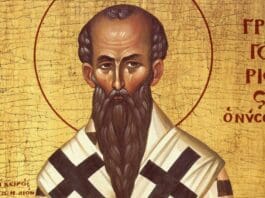
Saint Gregory of Nyssa, born in 335 and deceased in 394, was notably the offspring of two saints, Basil and Emmilia. Raised in present-day Turkey, his upbringing was heavily influenced by his elder siblings, St. Basil the Great and Macrina. Gregory’s academic prowess hinted at a promising future. Initially a professor of rhetoric, he later transitioned to ecclesiastical pursuits, influenced by his marriage and deep religious convictions. Despite not being bound by clerical celibacy laws at the time, he was ordained as a priest.
In 372, Gregory ascended to the role of Bishop of Nyssa, located in Lower Armenia, during a tumultuous era marked by the Arian controversy, which challenged Christ’s divinity. His tenure was briefly marred by a wrongful arrest over alleged embezzlement from the Church. However, his reinstatement in 378 was celebrated by his followers.
The passing of his brother, Basil, marked a turning point for Gregory. He emerged as a formidable opponent against Arianism and other theological disputes, solidifying his status as a guardian of Christian orthodoxy. His contributions were recognized in significant ecclesiastical assemblies, including the Council of Constantinople.
While Gregory’s legacy waned over time due to uncertainties surrounding his works’ authorship, 20th-century scholarly efforts have restored his prominence. Today, St. Gregory of Nyssa is revered not only as an orthodox figure but also as a seminal influence on Christian mysticism and monastic traditions.
Editorial credit: hramikona / Shutterstock.com
The post Saint Gregory of Nyssa appeared first on uCatholic.
Daily Reading
Friday after Epiphany
Reading I 1 John 5:5-13 Beloved: Who indeed is the victor over the world but the one who believes that Jesus is the Son of God? This is the one…
Daily Meditation
Be Made CleanQueda limpio
Click here for daily readings Leprosy. Now a treatable disease, it was once a sentence of shame, isolation, and gradual death. Because it is contagious, lepers were required to remain…




